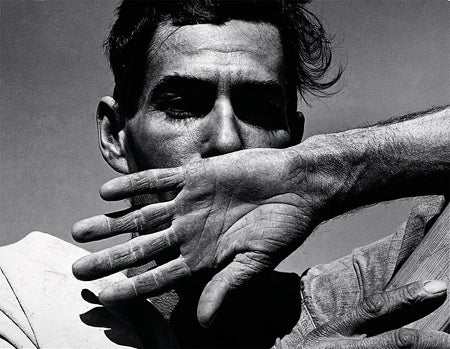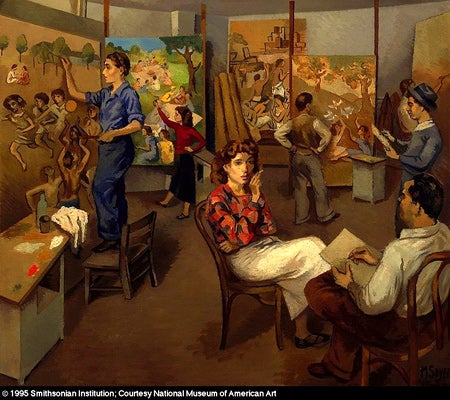
This installment of our Focus series presents an account of the Great Depression illustrated with selections from the numerous collections in the Artstor Digital Library that center on history.
The Great Depression was the longest lasting and most severe period of low general economic activity and unemployment of the 20th century. Lasting approximately a decade, it devastated economies around the world, leaving as much as a third of the population in some countries without jobs, and slashing international trade by more than half.

The Great Depression was triggered by the Wall Street Crash of October 29, 1929 (also known as “Black Tuesday”). The crash ensued from a speculative boom that began in the late 1920s in which hundreds of thousands of Americans invested in the stock market, many of them with borrowed money. As stocks started to tumble, investors rushed to sell, starting a panic. From Thursday, October 24 to Tuesday, October 29, stocks lost more than $26 billion in value. Prices continued to fall, and banks that had invested large portions of their clients’ savings in the stock market were forced to close, inciting another panic as people across the country rushed to withdraw money, which caused further banks to close. As a result of the crash, businesses had to lay off employees, cutting into consumer spending power, which in turn led to further businesses to fail, creating a severe downward spiral.

The situation was exacerbated by the Dust Bowl, a combination of drought and dust storms that decimated farmers. Small farmers typically borrowed money for seed and paid it back after the harvest; when the dust storms damaged the crops, famers went broke. Banks foreclosed on farms, leading to further unemployment and homelessness.
The slump in the American economy curtailed the flow of American investment credits to Europe, which particularly affected Germany and Great Britain, the two countries most deeply indebted to the United States after World War I. Unemployment rose sharply in Germany, reaching 6 million workers by early 1932, and Great Britain’s industrial and export sectors were badly bruised. A domino effect began to upset the rest of Europe’s economies. In an attempt to protect their domestic production, nations imposed tariffs and set quotas on foreign imports, halving the total value of world trade.
In the United States, Democrat Franklin D. Roosevelt was elected to the presidency in late 1932, and he instituted the New Deal: increased government regulation, such as the establishment of the Federal Depository Insurance Corporation (FDIC), the passage of the Securities Act of 1933, and the Securities and Exchange Act of 1934, and massive public-works projects to promote recovery, such as the AAA (Agricultural Adjustment Administration), the CCC (Civilian Conservation Corps), and the WPA (Works Progress Administration).

Roosevelt’s efforts brought some relief, but approximately 15 percent of the work force remained unemployed in 1939. It’s commonly agreed that unemployment dropped rapidly in the US after war broke out in Europe thanks to the new jobs in armaments and munitions factories. Recently, Alexander J. Field disputes this assumption, arguing in “A Great Leap Forward” that productive capacity increased during the Great Depression, and that is what led to the post-World War II boom.
Artstor Digital Library Collections:

The Carnegie Arts of the United States documents the history of American art, architecture, visual and material culture; Eyes of the Nation: A Visual History of the United States (Library of Congress) is a pictorial overview of American history through images from the Library of Congress’ special collections; George Eastman House offers the history of photography, including many key figures from the 1920s and 1930s; Museum of the City of New York features documentation of the built environment of New York City and its changing cultural, political, and social landscape, including more than a thousand photographs from the 1930s; Georgia O’Keeffe Museum has hundreds of works from that period by the legendary artist; The Schlesinger History of Women in America Collection includes hundreds of images by professional and amateur photographers documenting the era; Smithsonian American Art Museum Collection features more than 600 works by American artists, famous and forgotten, from the decade of the Depression; and, similarly, the Terra Foundation for American Art Collection, which also includes more than one hundred images by American artists of the period.
Using the Advanced Search function, searches limited to dates between 1929 and 1940 are rich with pertinent materials. Search for “unemployed” to find suitable images from the U.S. and Belgium, Nazi propaganda, and social realist paintings by lesser-known artists; search for “depression” to find hundreds of documentary photographs, images of fashions and architecture of the era, and diagrams of relevant economic statistics; and search for “WPA” for artwork and propaganda posters made for the program.
You can also find dozens of images by characteristic artists of the period such as Reginald Marsh, Ben Shahn, and Thomas Hart Benton, and documentary photographers such as Lewis W. Hine, Dorothea Lange, Walker Evans, and Berenice Abbott by searching for their individual names.


